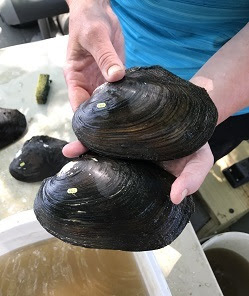Since 2017, DEC’s Division of Fish and Wildlife (Bureau of Ecosystem Health) has been working with the Saint Regis Mohawk Tribe, the New York State Museum, and DEC’s Division of Environmental Remediation to protect freshwater mussels in the Grasse River from being killed during the clean-up and burial of PCBs in the river. Led by the U.S. Environmental Protection Agency, the Grasse River Superfund cleanup includes both dredging and capping PCB-contaminated sediments along a seven-mile reach of the river.
It was estimated that during the clean-up, 1.2 million freshwater mussels—or 76% of the mussels—would have been lost. As a result of the recovery efforts, nearly 500,000 freshwater mussels have been saved and relocated. This represents an estimated 93% increase in the freshwater mussel population that will remain in the river following clean-up activities. Future recovery efforts include mussel propagation and release by the Saint Regis Mohawk Tribe, relocating some of the 500,000 mussels to form founder colonies, and improving river bottom habitat.
The Grasse River’s freshwater mussel community is remarkable for its density and diversity; at least 15 different species have been found here. Mussels perform critical functions such as nutrient cycling, maintaining sediment structure, and are food for other organisms.

Photo of heelsplitter mussels.
Source: Wildlife, Fish, and Marine Life Newsletter

